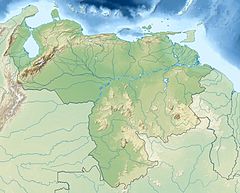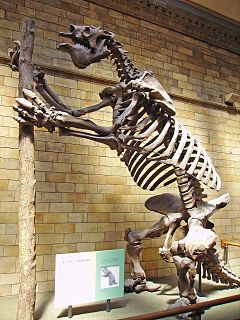
Megatherium is an extinct genus of ground sloths endemic to South America that lived from the Early Pliocene through the end of the Pleistocene. It is best known for the elephant-sized type species M. americanum, sometimes called the giant ground sloth, or the megathere, native to the Pampas through southern Bolivia during the Pleistocene. Various other smaller species belonging to the subgenus Pseudomegatherium are known from the Andes.
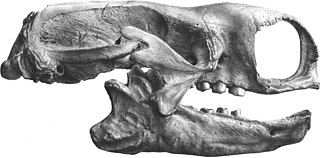
Mylodon is a genus of extinct ground sloth belonging to the family Mylodontidae, known from the region of Patagonia in Chile and Argentina in southern South America. With a total length of 3 to 4 m, it is one of the best-known and largest representatives of the group. The oldest finds probably date to the Lower Pleistocene; however, most of the fossil remains date from the Upper Pleistocene period. One of the most important sites of this phase is the Cueva del Milodón in southern Chile. Shortly after, about 10,200 BP, Mylodon became extinct. At this point in time, it coexisted with the first human colonists in America. However, there is little evidence that it was hunted by humans.

Homotherium is an extinct genus of machairodontine saber-toothed predator, often termed scimitar-toothed cats, that inhabited North America, South America, Eurasia, and Africa during the Pliocene and Pleistocene epochs, existing for approximately 4 million years.

Scelidotherium is an extinct genus of ground sloth of the family Scelidotheriidae, endemic to South America during the Late Pleistocene epoch. It lived from 780,000 to 11,000 years ago, existing for approximately 0.67 million years.
Haasiophis, consisting of the sole species Haasiophis terrasanctus, is an extinct genus of snakes with hind limbs. It is one of three genera of Cenomanian snakes known to have possessed hindlimbs.

Glyptotherium is a genus of glyptodont that lived from the Early Pliocene, about 1.8 million years ago, to the Early Holocene, around 7,000 years ago, in the United States, Mexico, Guatemala, Costa Rica, Honduras, El Salvador, Panama, Venezuela, and Brazil. Many specimens have been assigned to the genus, but the holotype, or name specimen, of the type species, G.texanum, was described in 1903 by notable American paleontologist Henry Fairfield Osborn. The holotype included a nearly complete carapace, tail, or caudal, armor, and several additional postcranial elements that had been found in the Pliocene Blancan Beds in Llano Estacado, Texas, USA. The genus has since been discovered from many more fossil sites and another species, G. cylindricum, was named in 1912 by fossil hunter Barnum Brown on the basis of a partial carapace, teeth, and several additional fossils that had been unearthed from the Pleistocene deposits in Jalisco, Mexico.

Hippidion is an extinct genus of equine that lived in South America from the Late Pliocene to the end of the Late Pleistocene (Lujanian), between two million and 11,000 years ago. They were one of two lineages of equines native to South America during the Pleistocene epoch, alongside those of the Equus subgenus Amerhippus.

Melbourne Bone Bed is a paleontological site located at Crane Creek in Melbourne, in the U.S. state of Florida. This site contains fossils from the Late Pleistocene period 20,000 to 10,000 years before present. The fossils include extinct animals such as varieties of camels, dire wolves, Florida cave bears, giant armadillos, giant beavers, giant bison, giant ground sloths, mammoths, mastodons, saber-toothed cats and tapirs.
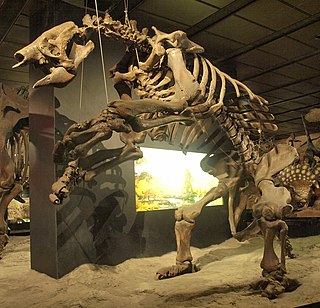
Eremotherium is an extinct genus of giant ground sloth, in the family Megatheriidae, the largest and most heavily built family of sloths. Eremotherium lived in the southern parts of North America and the northern parts of South America from the Pliocene, around 5.3 million years ago, to the end of the Late Pleistocene, around 10,000 years ago. Eremotherium was widespread in tropical and subtropical lowlands and lived there in partly open and closed landscapes, while its close relative Megatherium lived in more temperate climes. Both genera reached the size of today's elephants and were among the largest mammals in the Americas. Characteristic of Eremotherium was its robust physique with comparatively long limbs and front and hind feet especially for later representatives- three fingers. However, the skull is relatively gracile, the teeth are uniform and high-crowned. Like today's sloths, Eremotherium was a pure herbivore who dined on leaves and grasses, though it may have had semi-aquatic habits like modern hippos based on isotopic data. Eremotherium was a generalist that could adapt its diet to the respective local and climatic conditions of many regions. Finds of Eremotherium are common and widespread, with fossils being found as far north as South Carolina in the United States and as far south as Rio Grande Do Sul, and many complete skeletons have been unearthed.
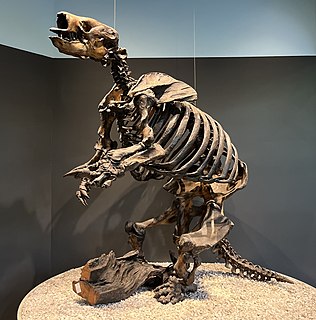
Paramylodon is an extinct genus of ground sloth of the family Mylodontidae endemic to North America during the Pliocene through Pleistocene epochs, living from around ~4.9 Mya–11,000 years ago. It is also known as Harlan's ground sloth.
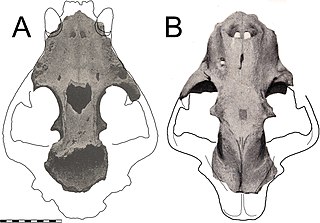
Panthera onca mesembrina is an extinct subspecies of the jaguar that was endemic to southern South America during the Pleistocene epoch. Its fossils have been excavated primarily in Argentina and Chile, though few fossils are known. Genetic analysis in 2016 showed that P. onca mesembrina was in an extinct sister lineage to extant Panthera onca species based on genetic evidence, and is the largest known subspecies of jaguar.

Scelidodon is an extinct genus of South American ground sloths. Its remains have been found in the Yupoí and Uspara Formations of Argentina, the Ulloma, Umala, Ñuapua and Tarija Formations of Bolivia, in Brazil, in Chile and in Peru. The youngest fossils have been dated to as recently as 9000 B.P.
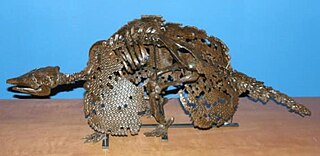
Pachyarmatherium is a genus of extinct large armadillo-like cingulates found in North and South America from the Pliocene and Pleistocene epochs, related to the extant armadillos and the extinct pampatheres and glyptodonts. It was present from 4.9 Mya to 11,000 years ago, existing for approximately 4.889 million years.
Ahytherium is an extinct genus of megalonychid sloth that lived during the Pleistocene of what is now Brazil. It contains a single species, A. aureum.
Australonyx is an extinct genus of ground sloths, endemic to South America during the Late Pleistocene. It was found in Brazil.
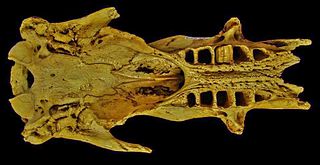
Diabolotherium is an extinct genus of megatheriine ground sloth, known from the Late Pleistocene of Peru. Unlike most other extinct mainland sloths, it seems to have been a climber, similar to extinct sloths from the Caribbean. Fossils of the genus were found at the coastal Piedra Escrita site and the Andean Casa del Diablo cave.
Valgipes is an extinct genus of scelidotheriid ground sloth, endemic to intertropical Brazil and Uruguay during the Late Pleistocene. Thought to have been a forest-dwelling browser, Valgipes is a monotypic genus with a complex and long taxonomic history, and is a close relative of Catonyx and Proscelidodon.
Xibalbaonyx is an extinct genus of megalonychid ground sloth known from the Late Pleistocene of Mexico. Three species are known: X. oviceps and X. exiniferis from the Yucatan peninsula and X. microcaninus from Jalisco. The genus is named after Xibalba, the underworld in Maya mythology.
Nohochichak is an extinct genus of megalonychid ground sloth from the Late Pleistocene (Rancholabrean) of the Yucatan Peninsula in Mexico.
Archaeomylodon is an extinct genus of mylodontine ground sloths that lived during the Middle Pleistocene of what is now Argentina. It is known so far only from a single skull, which in its dimensions corresponds to those of the giant Lestodon. However, the skull differs from this one by its narrower and higher snout. In addition, the anterior canine teeth, which are usually large in many mylodonts, are greatly reduced. The find comes from the Pampa region of South America and was deposited in about 700,000 years old sediments.
